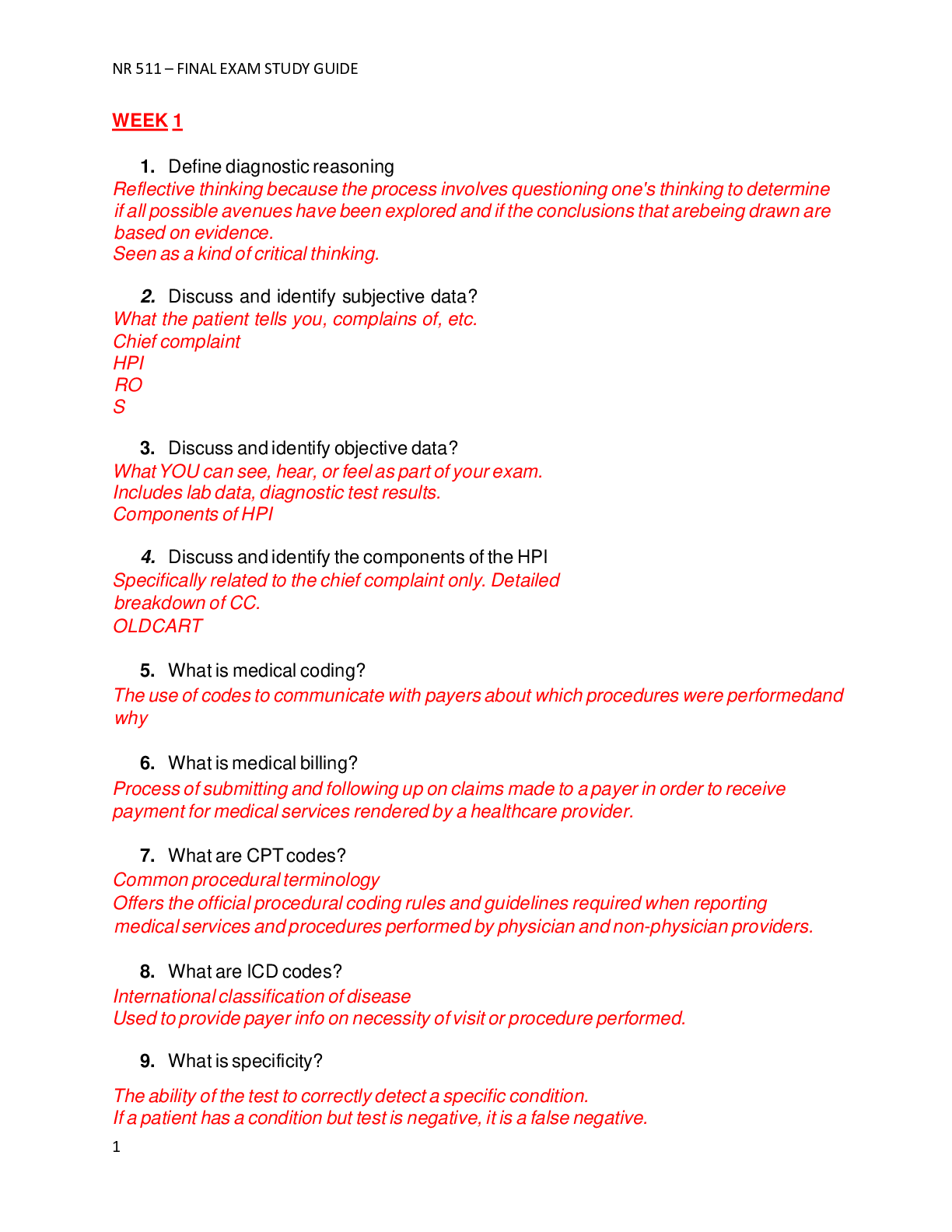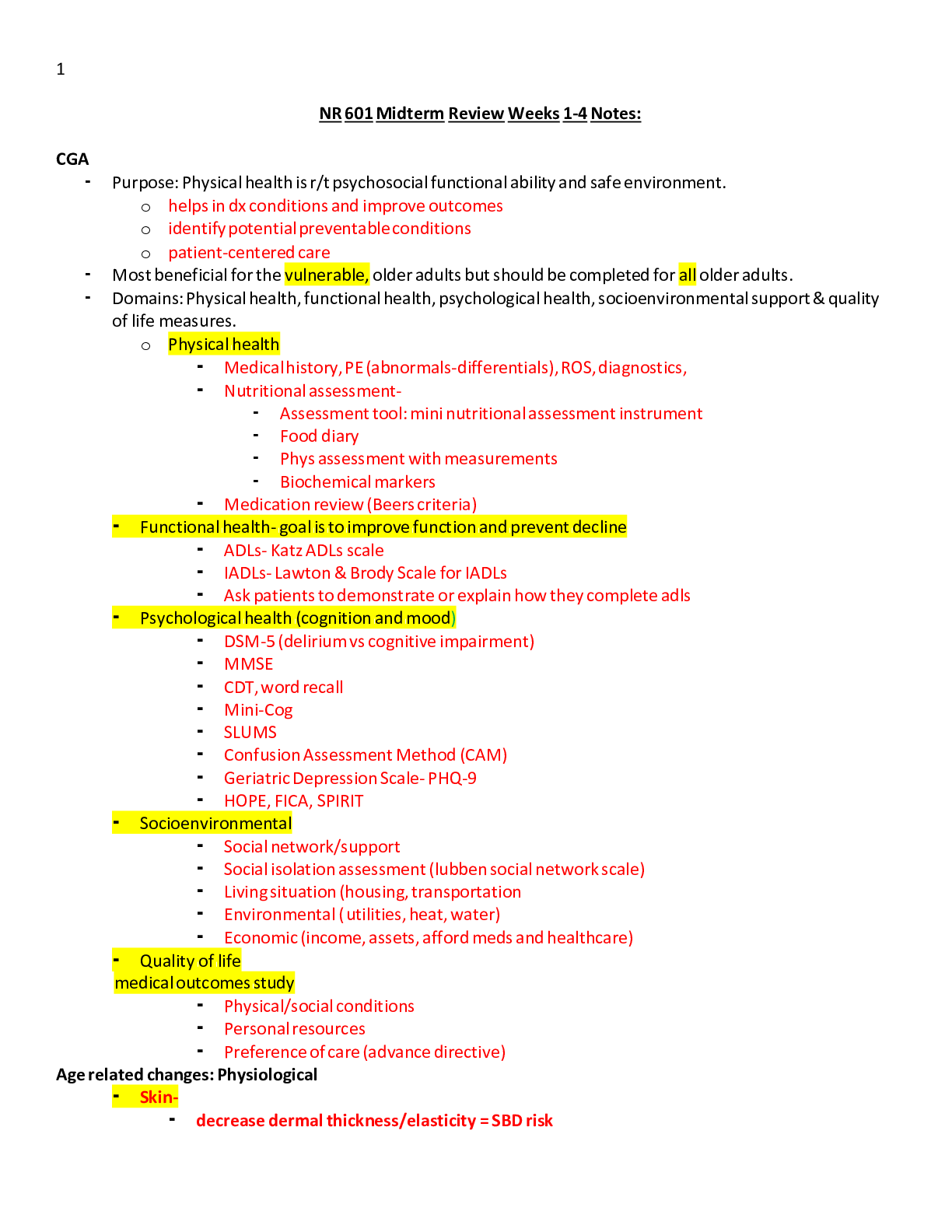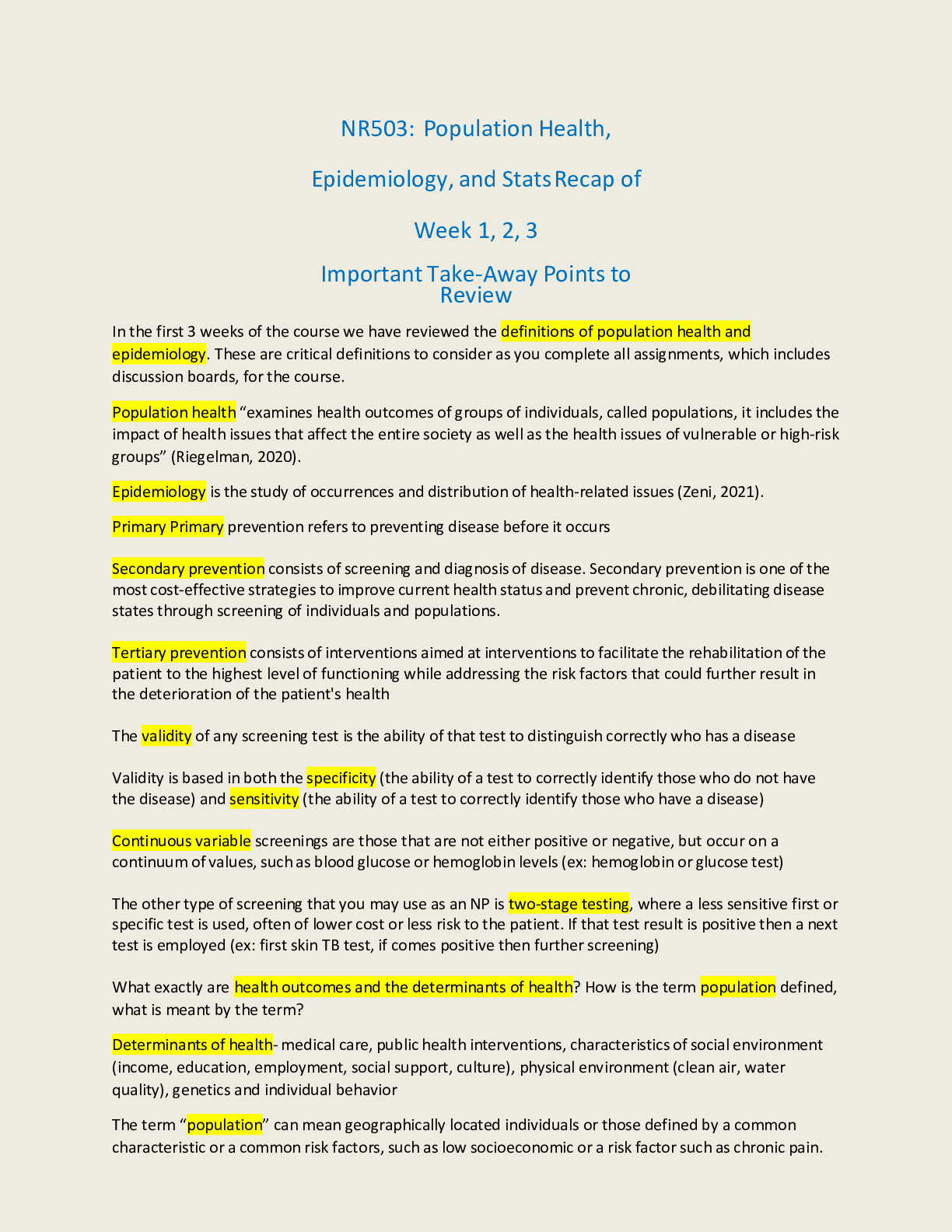*NURSING > STUDY GUIDE > NURS 6541 Week 1, 2, & 4 Journal Entry; Primary Care of Adolescents and Child (All)
NURS 6541 Week 1, 2, & 4 Journal Entry; Primary Care of Adolescents and Child
Document Content and Description Below
NURS 6541 Week1, 2, 4 Journals Week 1, 2, & 4 Journal Entry Walden University Primary Care of Adolescents and Child NURS -6541-NWEEK 1, 2, & 4 JOURNAL ENTRY 2 This week was an exciting one meet... ing with my preceptor, and starting a new role with pediatric experience and I was introduced to the office staff by my preceptor. My preceptor and I went through my course objectives and goals. I had the opportunity of seeing patient presenting with interesting diagnosis. On my first day, I met with a pediatric patient, and my preceptor introduce me to the parents first who is Spanish-speaking only. I introduced myself to the young child who is 4yrs old, and parents then interacted more with the parent, when the child see me interacting with his parent, he then have trust in me. It is necessary to utilize all the resource when the parent is present. The detailed information about the child's illness is received from the parent. Strengths and WeaknessesWEEK 1, 2, & 4 JOURNAL ENTRY 3 I am a nonjudgmental person, but I if I experienced a situation of child abuse or neglect suspicion, it is emotionally difficult to handle, especially if children are directly involved because they are defenseless and are open to harm. It is important to separate myself professionally from situation like this and maintain an unbiased opinion and behavior. Learning more about children is a great passion that I look forward to, I am emotional when faced with challenges taking care of children with a terminal condition such as cancer that I encounters in the hospital setting where I practice but is that taking care of sick seeing them recovery makes me excited and I am looking forward to that excitement during my practicum time. The comfort theory Comfort is defined as to soothing, relief and ease when in anguish or sadness; it help to relief pain, worry, makes life easy and reducing of sadness or misery by reassuring, comforting, or inspiring with hope. According to (Kolcaba & DiMarco, 2005) comfort is defined as an instant state of strength through human needs for relief, ease, and transcendence addressed using physical, psychospiritual, sociocultural, and environmental approach. (Medscape, n.d) The responsibility of the nurse is help meet striving children and families with basic comfort needs; comfort is an active which requires the nurse to be supportive when discomforts such as environmental chaos or pain cannot be prevented. Children and families are assisted to experience complete transcendence with comfort interventions that carry hope, achievement, caring, and support for their distress. (Medscape, n.d) According to (Kolcaba & DiMarco, 2005)The ability to rise above discomfort is called transcendence it gives nurses power and reminds them to "under no circumstances giveWEEK 1, 2, & 4 JOURNAL ENTRY 4 up" assisting children, and families feel comforted by improving the environment, increasing social support, or providing reassurance especially during developmental stages by encouraging school-aged children and adolescents. Appling comfort theory by encouraging and giving instructions for motivational messages when caring for school age and adolescent, developmentally, the experience of strengthened, empowered or courageous. (Kolcaba & DiMarco, 2005) My Goal and Objectives for the practical experience 1. I will demonstrate critical thinking and diagnostic reasoning skills in clinical decision, provides counseling on healthy environments,community needs, and resources and application of principles of epidemiology and demography during my pediatric practicum period. 2. I will be able to assess the patient’s educational needs, by creating an effective learning environment, designs personalized plan for learning according to age specific, provides health education, coaches the patient and parent for behavioral changes and evaluates the outcomes of patient education. 3. I will understand how to analyze data, to determine, formulate a diagnosis, health needs or problems and develop a differential diagnosis of a pediatric population during my practicum period. 4. I will help to apply preserves patient control over decision making, create mutual trust, provides comfort and emotional support, negotiates mutual acceptable plan of care, and maintains confidentiality and privacy with patient and parent during my pediatric practicum period.WEEK 1, 2, & 4 JOURNAL ENTRY 5 5. I will be able to demonstrate competence in culturally-sensitive care, prevents personal biases , provides culturally sensitive care, and incorporates cultural preferences, values, health beliefs and behaviors into the management of pediatric population 6. I will be able to talk to as many parents during my practicum period to explore their fears and emotions during my pediatric practicum period. 7. I will explore the fears and emotions of parent and caregiver, and fully appreciate what a parent may be dealing with during my pediatric practicum period. Week 2 Journal Entry Failure to Thrive The patient described from my practicum experience is a 3years-old Africa American underweight with diagnosis of failure to thrive. Failure to thrive is the weight for age that falls below the 5th percentile on different occasions. It is a term used to describe inadequate growth usually in early childhood. It is a sign of undernutrition which are caused by biologic, psychosocial, and environmental processes can lead to undernutrition. (" Failure to thrive: an update," n.d) Diagnostic Evaluation of Failure to Thrive. An accurate, history of child’s eating habits, caloric intake, and parent-child interactions should be obtained to determine the cause of FTT. Observing the 5 years old eating habits is helpful in evaluating for picky eating. Teach parents to maintain three days food journal. Inquire about food habits and eating. It is essential to get psychosocial historyWEEK 1, 2, & 4 JOURNAL ENTRY 6 which helps with detecting maternal or patient depression, (" Failure to thrive: an update," n.d) Assessing and Managing Patient with failure to thrive and Family A 3 year old child was examined to ensure accurate measurements of height (or length), weight, and head circumference that was plotted on an appropriate growth chart. Undressed the child for a thorough examination, assess the child for signs of physical abuse or neglect, such as recurrent, unexplained injuries and also look for signs or symptoms of medical conditions that might be causing Fitting this case, this child stays at home two teenage girls who take care of the 3years-old when Mom goes to work. At the clinic, on physical assessment there is evidence of abuses such as uncut and dirty fingernail, unwashed clothing, and skin diaper rash. An interdisciplinary effort is needed to protect the child so that the problem of abuse can be effectively addressed. The cause of FTT of the 3year-old child is abuse, which was addressed by restoring her nutritional intake, providing nutritional rehabilitation, providing parent education, support and evaluating normal weight gain and making referrals as needed which includes nutritional.(Burns, Dunn, Brady, Starr, & Blosser, 2013). Week 2 Journal Experience I met with my preceptor on that particular day which was Monday, we both rounded on in-patients, and she took time to explain the reason while they were hospitalized. This was a busy week, and I had the opportunity of seeing patient presenting with interesting diagnosis, such as the 3 year-old who was brought to the with complaint of child not growing well. I had the opportunity of assessing a child for normal and abnormal growth and development, developmental red flags, and applying key terms, principles, andWEEK 1, 2, & 4 JOURNAL ENTRY 7 concepts related to growth and developmental issues for infants, toddlers, and preschoolers. It is challenging to manage child abuse in any setting. It is best managed with a multidisciplinary team, which follows an established guidelines to maintain objectivity and thoroughness. The “aha” moment was when the 3 year- old child Mom was notify about calling CPS, she was aggravated. One of the management is a referral to child protective agency (CPS), and this statement aggravated Mom, my preceptor made me understand that we as the clinician are our patient advocate. A referral to local resources which include social workers, child abuse physician, CPS, and law enforcement for early evaluation. Neglect is legally reportable, and nutritional neglect is likely the most common form of neglect. ("Child Abuse," n.d) Objectives and Goals for Week 2 This week I will demonstrate the ability to assess pediatric patients with signs of growth and development or psychosocial issues. I will apply and understand the key terms, principles, and concepts related to growth and developmental issues for infants, toddlers, and preschoolers by the end of the week. I will differentiate between normal and abnormal growth and development of infants, toddlers, and preschoolers. I will be able to analyze the stages of physical, social, and cognitive development for infants, toddlers, preschoolers, and assess patients for developmental red flags of abnormal development. Week 4 Journal EntryWEEK 1, 2, & 4 JOURNAL ENTRY 8 Temper Tantrums on a Toddler The patient described from my practicum experience is a 20 month-old Hispanic child with growth and developmental issues of a temper tantrum, and it is a normal child developmental processes which occur between the 1-3 years. It is a common problem experience with 50% to 80% of children and it usually peak at 18 to 20 months. Temper tantrum may be mild such as whining and pouting and full blown by yelling, crying, flinging and kicking on the floor. Children display temper tantrum to express their feeling of frustration compounded with not able be in control.Toddler struggle with a temper tantrum when they are tired or hungry and to express and communicate their desire. For example, when a child becomes frustrated trying to button or when she wants to stay awake a temper tantrum may happen. (Burns et al., 2013, p. 88) Management of Temper Tantrums Educating families on prevention of temper tantrum issues should be discussed in detail to help prepare them for behavioral and social issues that may occur during a child’s growth and development. Educate parent to be supportive, establishing behavioral standards, recognizing a child’s achievements, and encouraging healthy peer and sibling relationships. Clinician should educate parent to give the child enough attention, and provide specific praise in successful moments. Although most tantrums happen in ages 1- 3year some children still throw tantrums in the school, instruct parent to prevent the child from hitting, kicking, biting, or throwing, do not ignore the child. Create a zerotolerance policy, be sure that the child is safe prevent from physical risk such as running into the street make it very clear that hitting or biting is unacceptable, take away all privileges. ("Temper Tantrum," n.d)WEEK 1, 2, & 4 JOURNAL ENTRY 9 Follow- Up Care A referral for cognitive-behavioral therapy may help the parent to learn how to apply positive behavior and help the toddler develop good behavioral habits for the future. (Burns et al., 2013).If a child continues to exhibit slow recovery time on temper tantrum at home than outside home and more aggressive behavior toward others a referral to neurodevelopmental or psychiatric specialist should be done.(Domino, Baldor, Gording, Grimes, & Taylor, 2013, p. 144) Week 4 Journal Experience This week was an interesting one with my practicum experience. It was a very busy one seeing patient with interesting diagnoses such as ear infections and children with behavioral issues. I saw patient independently and was able arrived at my differential diagnoses which were always finally confirm by my preceptor. I met with parent and children with different issues that affects their kids [Show More]
Last updated: 1 year ago
Preview 1 out of 11 pages
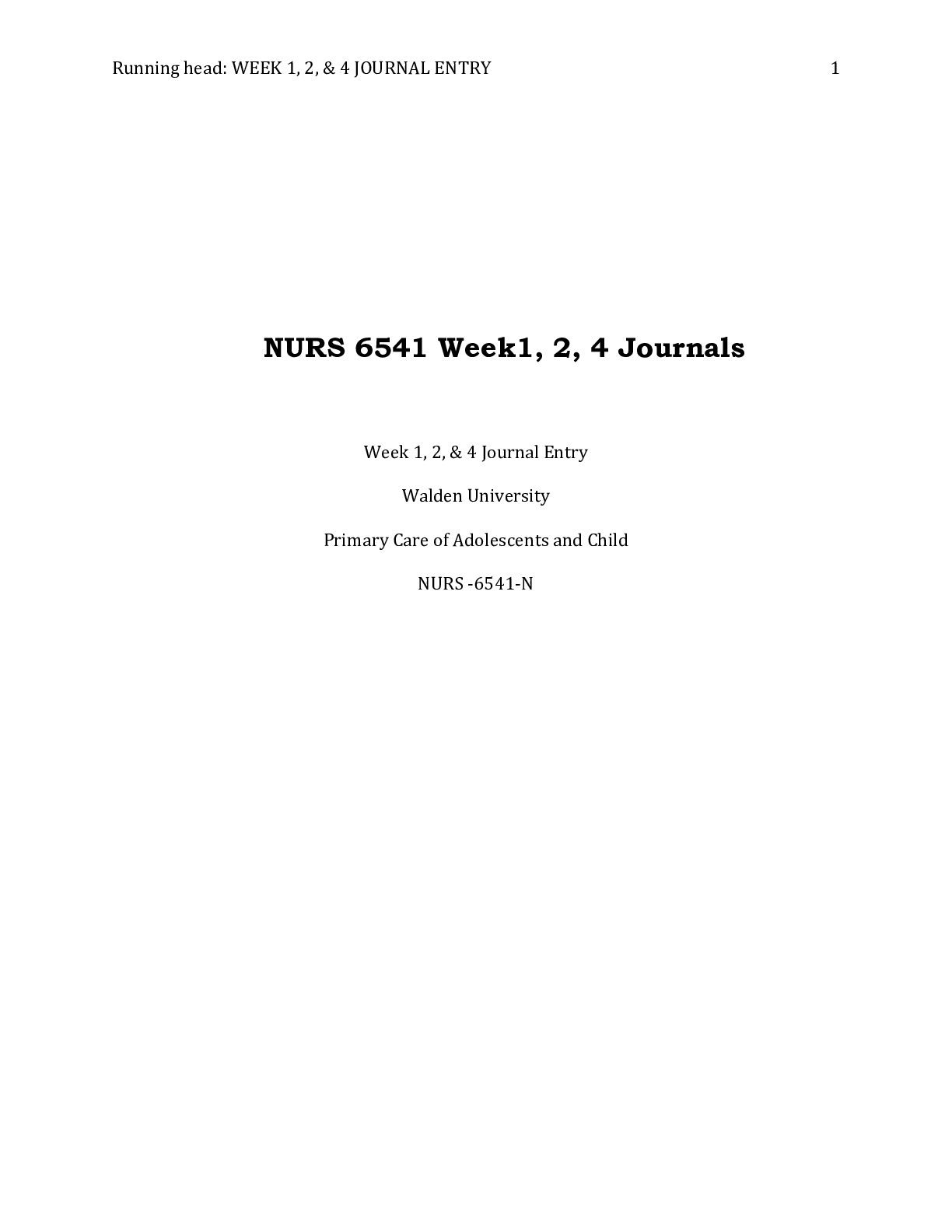
Buy this document to get the full access instantly
Instant Download Access after purchase
Add to cartInstant download
We Accept:

Reviews( 0 )
$8.00
Document information
Connected school, study & course
About the document
Uploaded On
Jan 27, 2021
Number of pages
11
Written in
Additional information
This document has been written for:
Uploaded
Jan 27, 2021
Downloads
0
Views
42

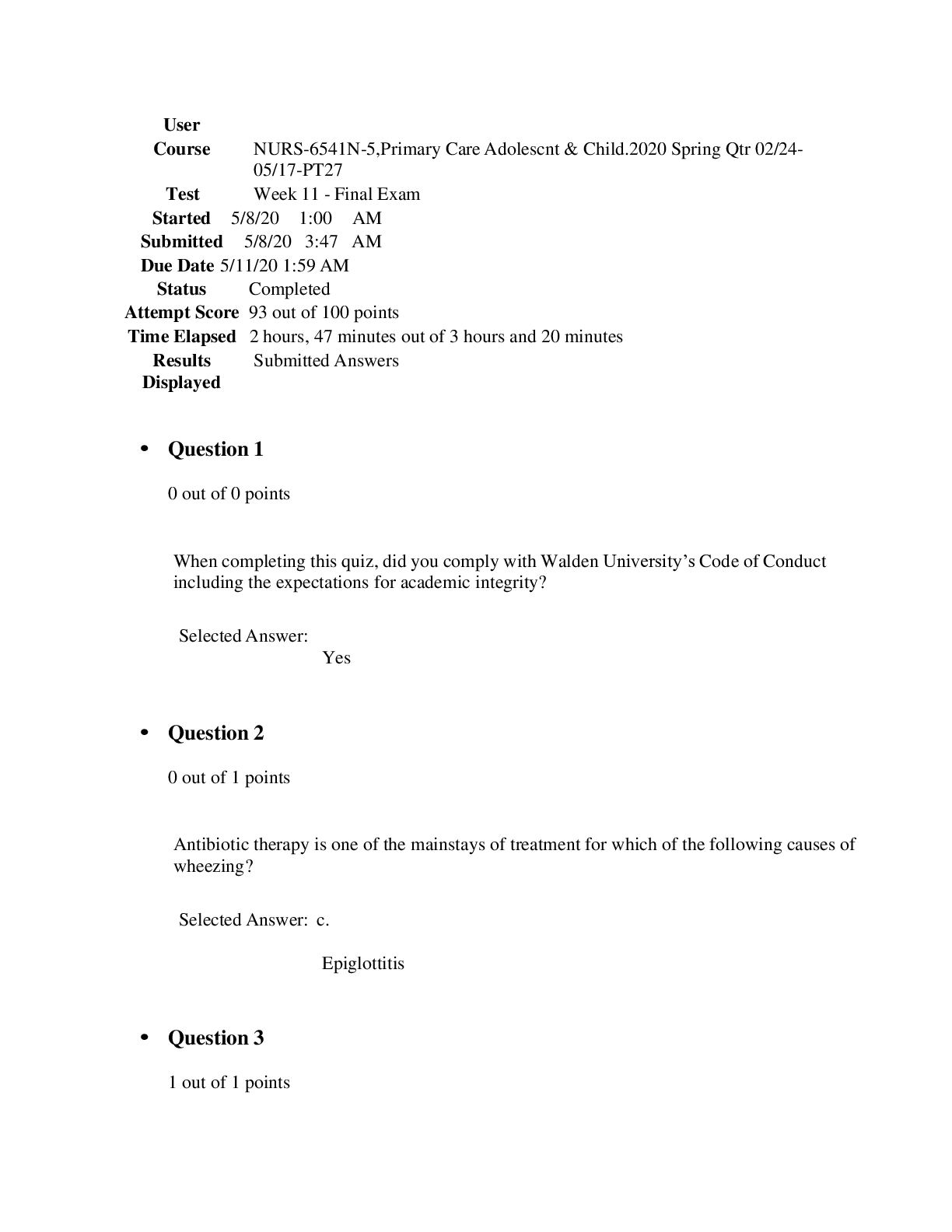
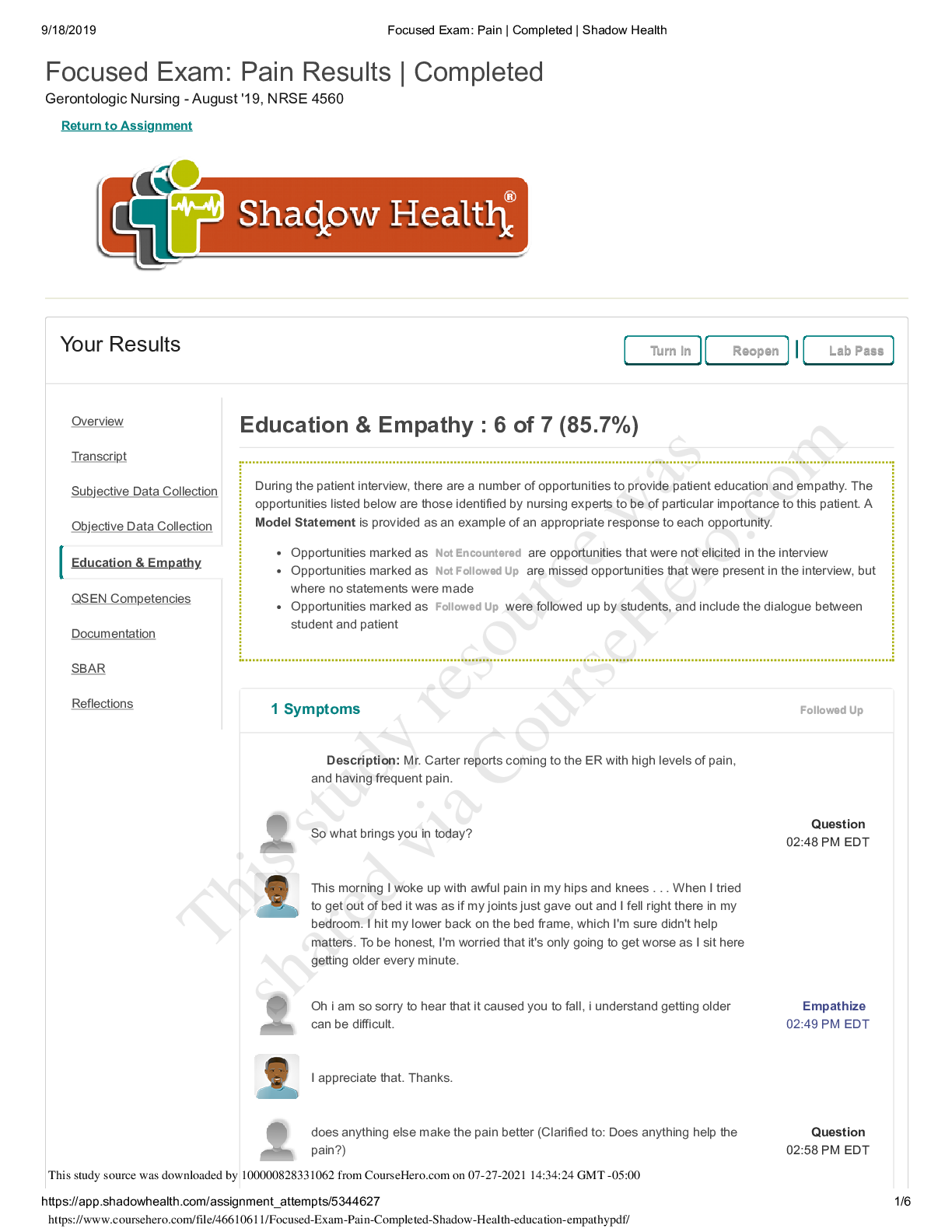

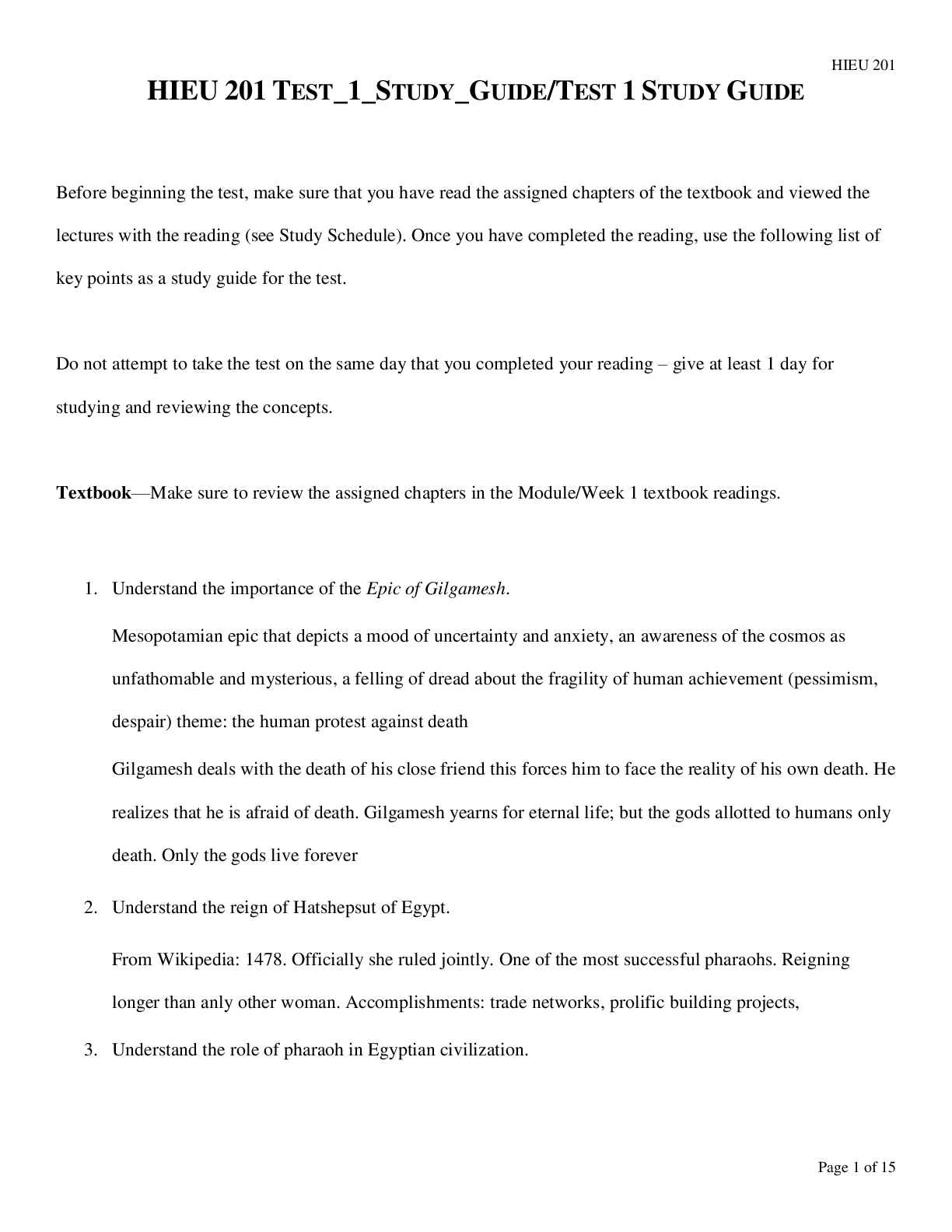

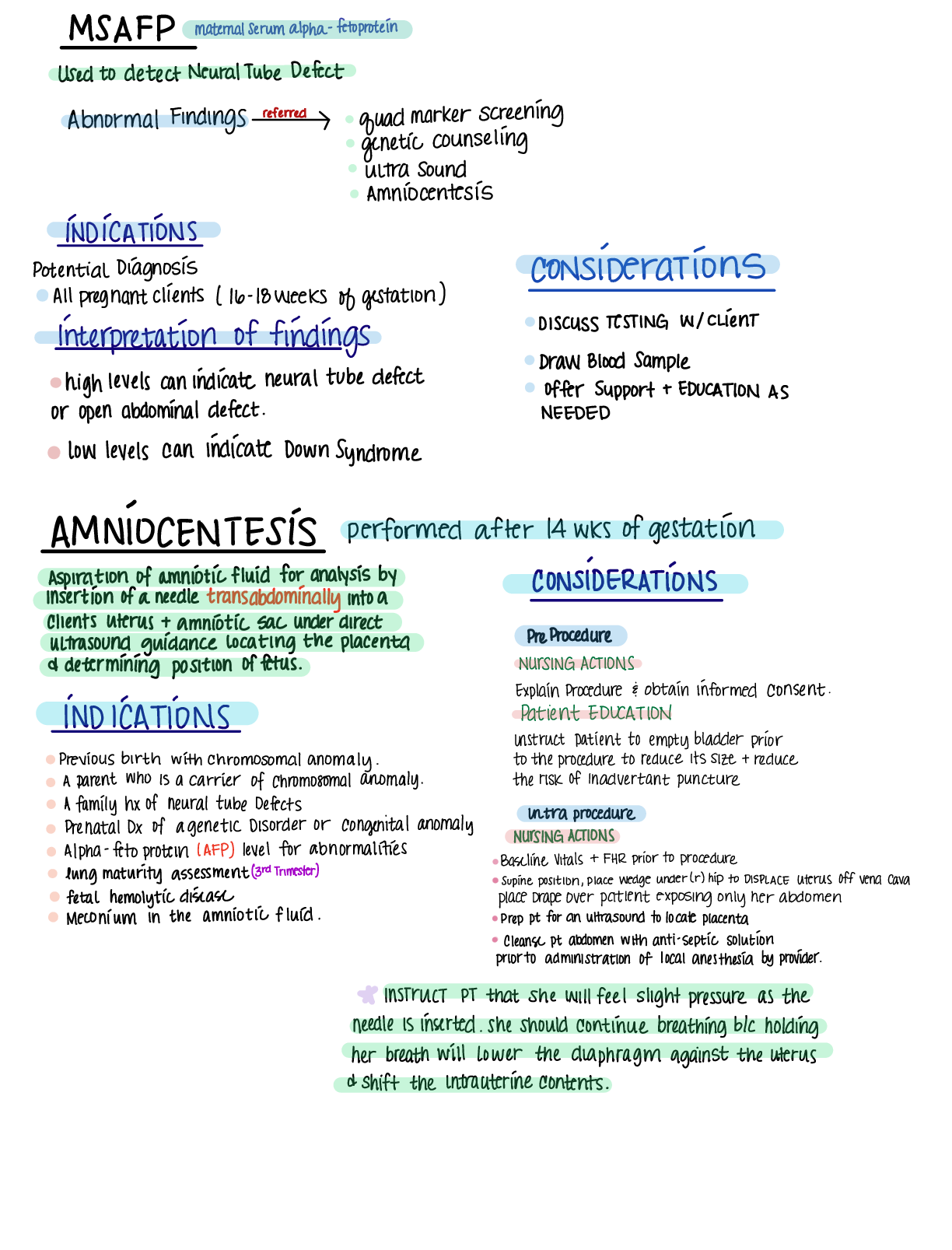



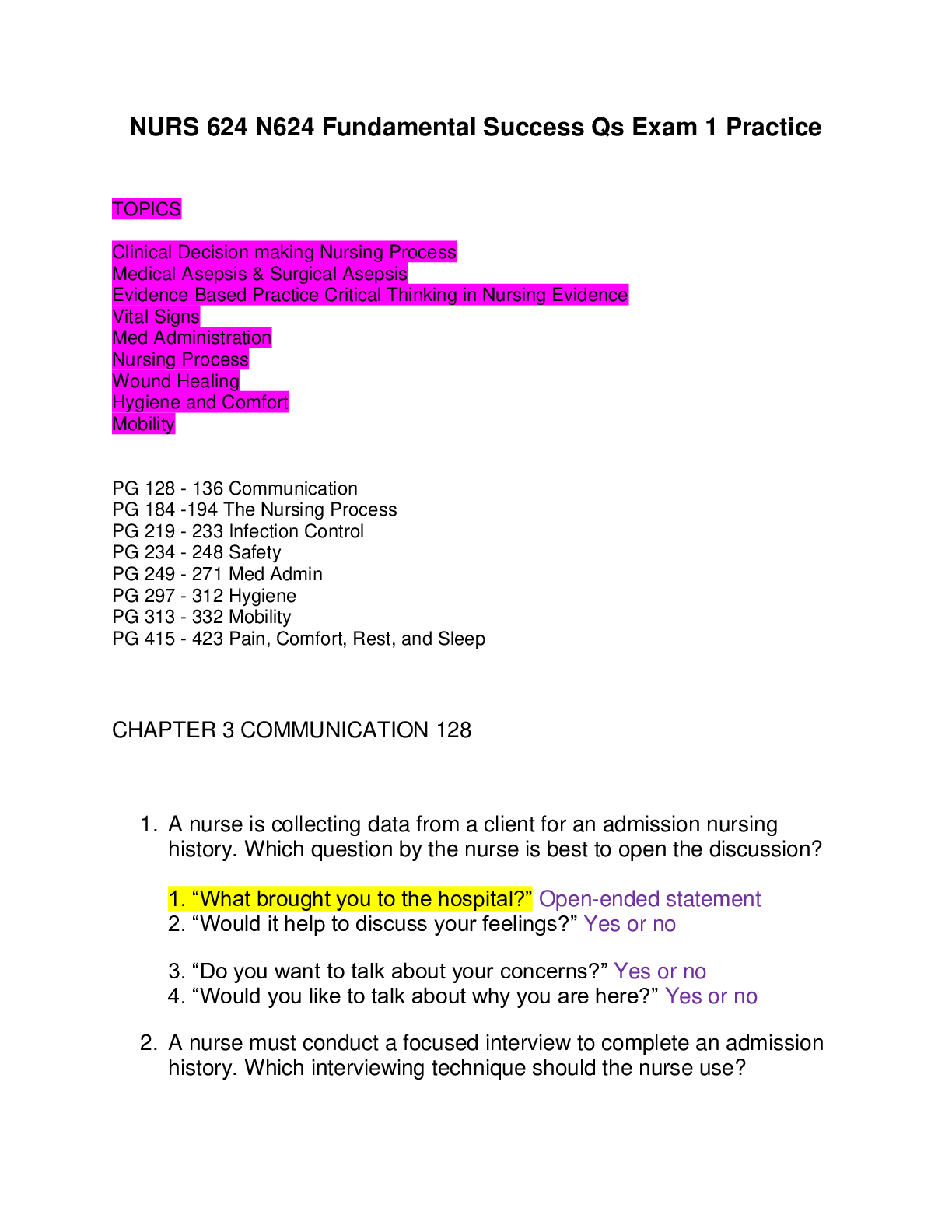
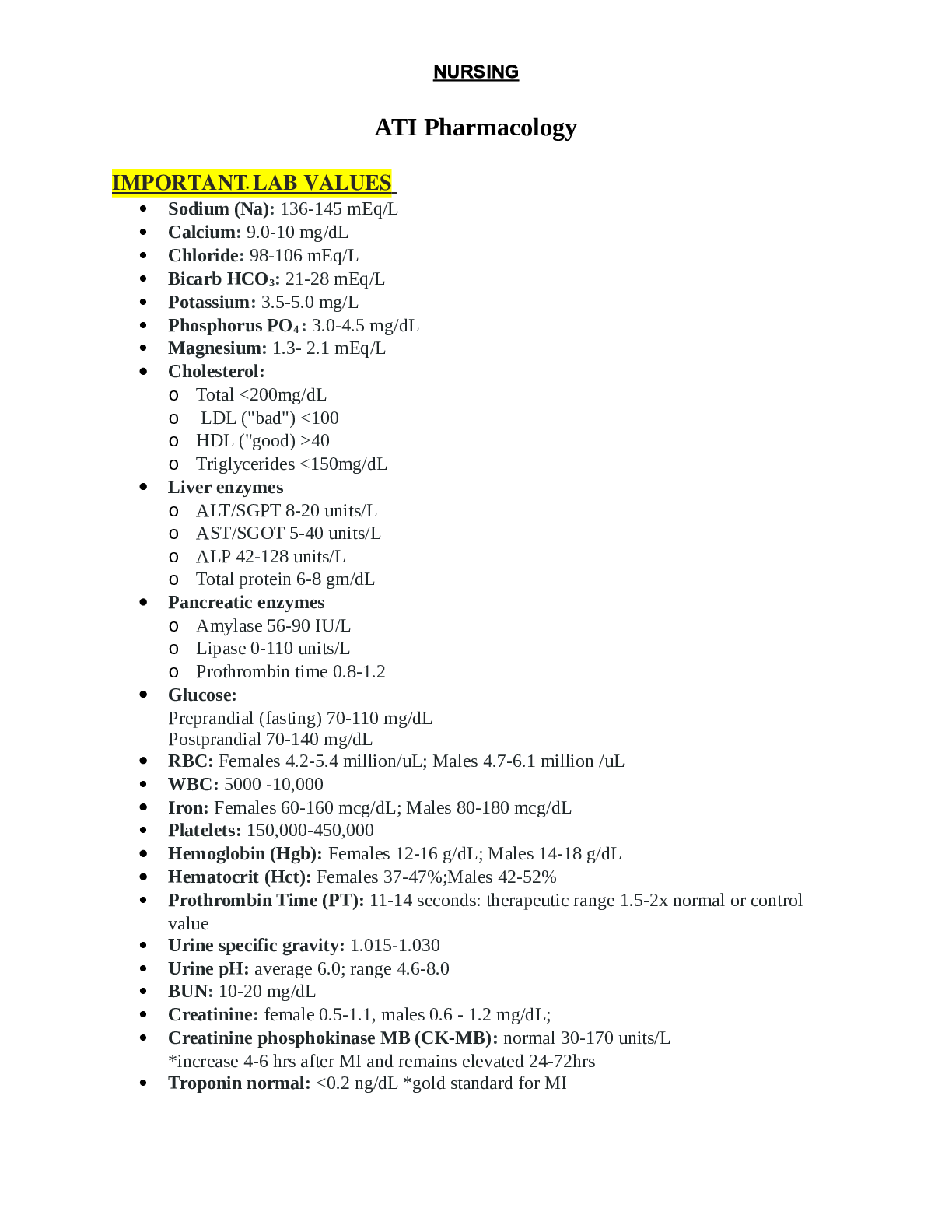

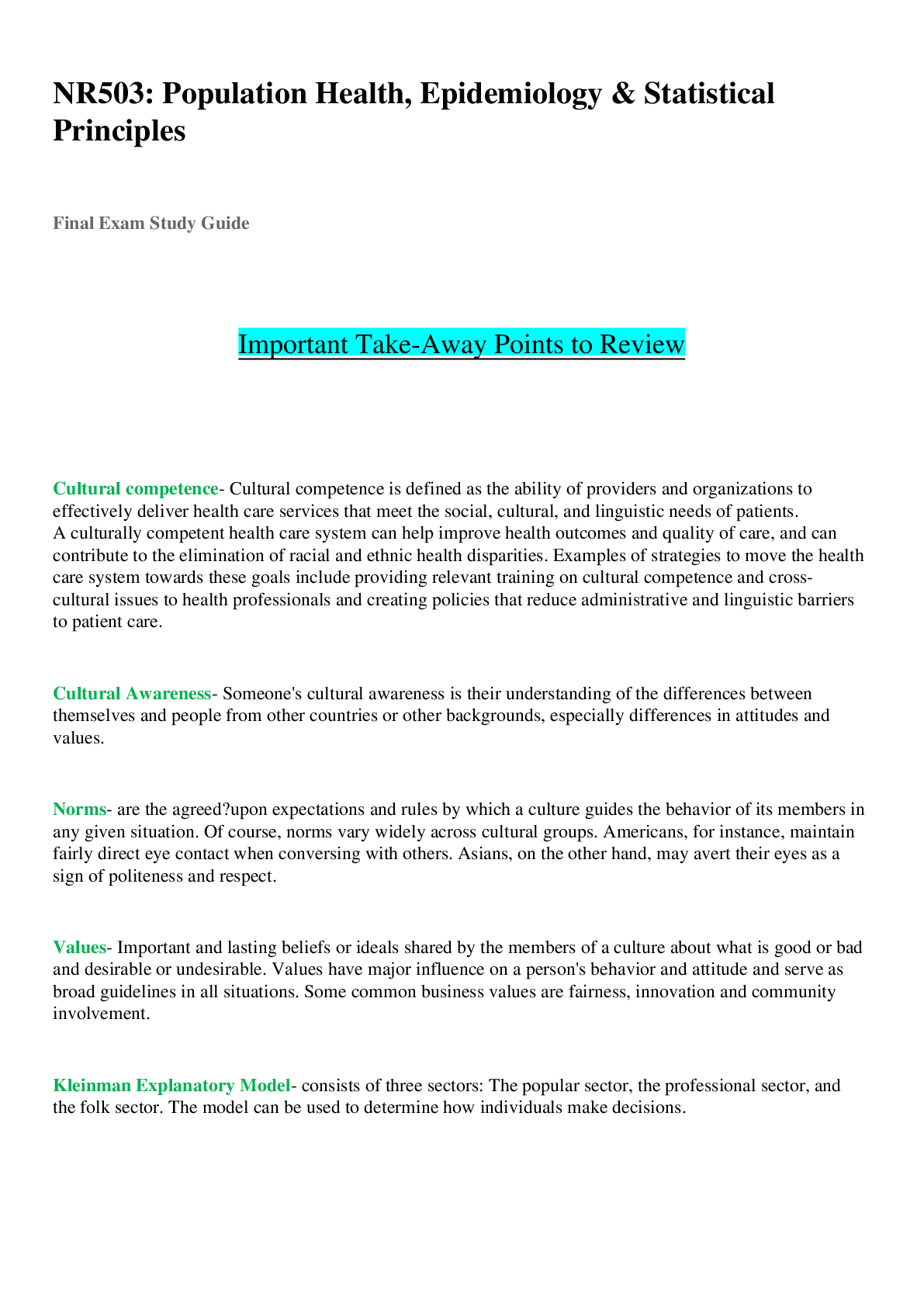
 F21.png)
 Correct Answers, Download to Score A.png)
 Correct Answers, Download to Score A.png)
